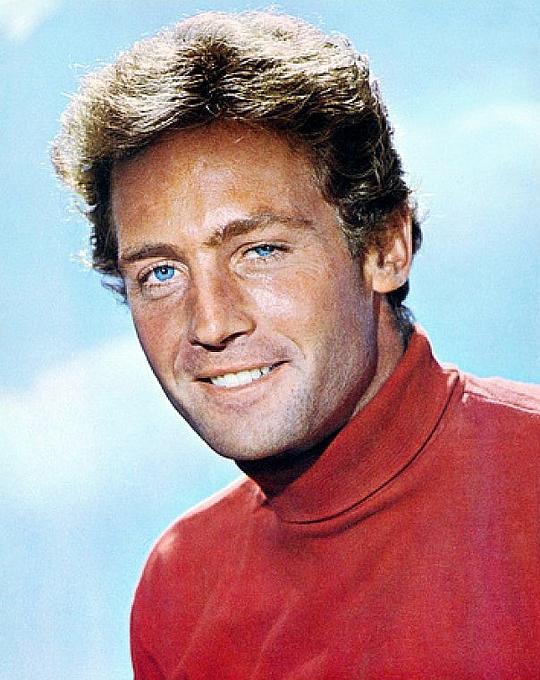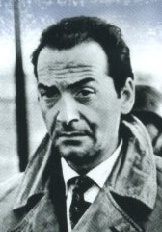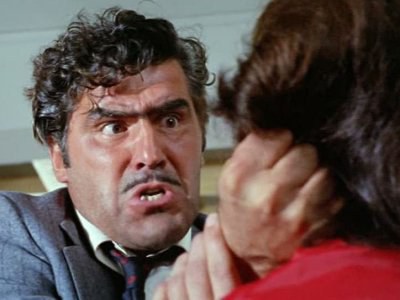撒旦的面具 La maschera del demonio(1960)

又名: 黑色星期天 / Mask Of The Devil / Black Sunday / The Mask of Satan / Revenge of the Vampire
导演: 马里奥·巴瓦
主演: 芭芭拉·斯蒂尔 约翰·理查森 安德烈·切齐 伊沃·加拉尼 阿尔图罗·多米尼奇 恩里科·奥利维耶里 安东尼奥·皮耶尔费代里奇 迪诺·比安奇 克拉拉·宾迪 Mario Passante 雷纳托·泰拉 Germana Dominici
类型: 恐怖
制片国家/地区: 意大利
上映日期: 1960-08-11
片长: 87 分钟 IMDb: tt0054067 豆瓣评分:7.1 下载地址:迅雷下载
简介:
- A vengeful witch and her fiendish servant return from the grave and begin a bloody campaign to possess the body of the witch's beautiful look-alike descendant. Only the girl's brother and a handsome doctor stand in her way.
演员:
影评:
- 作为一部在恐怖电影历史中颇具里程碑意义的影片,“撒旦的面具” 融合的恐怖元素。
资料显示这部电影是基于果戈里的小说VIY创作的。科普viy了解,这是过去英国一个名叫 Little Russia 的地方对侏儒精灵老大的称号,传说这位精灵老大的眼睫毛可以拖到地面(是因为矮还是睫毛长就没有兴趣研究了)。然而果戈里的故事精简概括就是一个学生与女巫、魔鬼在教堂的终极战斗。学生因为对魔鬼的恐惧最终死亡,而邪恶力量因为战斗过瘾没有发现天亮了还待在教堂里(太无脑了吧。。。)被永久封印在教堂里,最终教堂被废弃。
本部电影借鉴的就是小说中女巫借体复活,以及女巫召唤魔鬼这两个元素。
电影从极刑开篇就使用各种元素,进行对比。导演不愧是摄影师出身,光影对比掌握太好,以至于这部黑白电影在营造恐怖氛围上并不输给任意一帧彩片。
电影手法就不去深入讨论了,随便网上搜搜有大量对这部的分析与膜拜。随手记录几句喜欢的台词侧面膜拜下意大利人充斥着骨血的哥特式浪漫情怀吧。
背景是Katia公主在经历父亲恐怖死亡以及诸多恐怖事件后独自漫步在城堡凄凉的花园遇到钦慕她的医生Andre
Andre: Princess Katia, I hope I did not interrupt you
Katia: No, I just feel so desperate and alone
Andre: I understand, But you must not fear. You must always have faith in yourself, and in life.
Katia: In life? What is my life ?
Sadness and grave, something destroys it day by day, and no one can rebuild it.
Katia walk to a stagnant pool
Katia: Here is the very image of my life. Look at it, it is being consumed hour and hour, like this garden.
Abandoned, and purposeless exists.
Andre: If there is the man who abandoned this castle, or even there is...
There should be no reason why you should do likewise to your life and to you.
Go far away from here, and you will be happy again, Katia.
Forgive me if I call you by name.
And remember, I am always ready to help you.
Katia: You are very kind man, Andre. But today, everything seems so hopeless. I fear sense of terror, resemblance of death.
I am being destroyed by something inside my body.
How I wish I could have your faith and strength.
Andre: You must not be despair, I know it's hard for you. But even in here in this garden, the sun will reach the darkness corner, chase away the shadow of the night.
Katia: Andre, help me. I beg you to help me.
...
最后小感,往往是suffer的越痛苦,魔鬼的力量越强大。而往往是内心越坚定,对抗魔鬼的战斗力越强。修炼强大的内心太重要了。。。 
现在已经可以肯定,这是今年我看过的气氛最好的恐怖片:神秘森林里处处是盘根错节的诡异,仿佛下一根枝条就要扼住你的喉咙;黑色的巨犬在午夜绝望的吠叫呜咽,与身边站立着的苍白少女形成鲜明对比;浓雾每每在恶魔出现时渐迷人眼,每走一步腾起的烟雾都像是行走在云端的危险;结满蜘蛛网的半塌城堡承受着诅咒,在人们的恐惧中失去了存在的意义;光影亦正亦邪在人脸上跳跃,在火焰半明半暗间舞出救赎与复仇的姿态;充满了正义感却执行着血腥屠杀的人们绘注了全片的经典,这才知道原来恐怖片《神殿》完全是对本片的一次借鉴与不成功的模仿。
影片以十七世纪一名女巫和其情人被族人杀死开始,戴上面具的经典镜头成为本片的海报,相信每个看过该镜头的人在锤子落下的那一刻都会感到脸疼。两个世纪之后,科学和技术逐渐打破了迷信、削弱了宗教的力量,两名医生仅仅因为兴趣所在而不小心释放了女巫,之后的斗智斗勇在精心营造的恐怖气氛下丝毫没有早期恐怖片的拖沓之感,成功的哥特风格似乎让我闻到了数百年前的中世纪潮湿气息:那些默默的承担了几千年恩怨情仇的建筑、那些沉淀在人们心底受诅咒的恐惧感、那些为爱追寻为情受苦坚定自己看见了整个世界的情痴们,统统被同一个恶魔吞噬,叫孤独。
女主角一人分饰两角,也许是因为长相实在不敢恭维的原因,在她唯一一次捂脸哭泣时竟是极美的。在最后女巫与少女争夺身体时,以一个长镜头表现少女从曼丽到衰老的过程真心精彩,化妆和剪辑配合的天衣无缝,所以当女人再次从老妪变回少女时再欣赏一次这种特效也相当赏心悦目。这种特效同样表现在女巫从一个骷髅慢慢长出了骨碌碌转的眼珠上,红颜枯骨的残酷美几乎令人心碎。

而说到化妆,其实现代人看多了奇形怪状的怪物洗礼后再看片中腐烂掉渣的鬼脸并不足为奇,然而此刻彰显的正是光影和配乐的魅力。在阴影中一张若隐若现的腐烂的脸毫无生气的向你靠近,惊吓的面孔与魔鬼的脸庞交叉出现更加深了观者的恐惧心理,这种效果尤其在黑白电影中展现的最完美。而在森林中那些横生诡异的树枝、看似清澈却深不见底的池塘、在常年不散的浓雾中悄然矗立的墓群、象征着正义的十字架歪歪斜斜无不像一篇复活了的童话,阴冷的缠住童年的噩梦直至窒息。

影片中出现的十字架是大主教十字,又称拜占庭十字,是基督宗教符号圣十字架的一种变体。与拉丁十字基本相似,但上方多了一个小横杠。在拜占庭希腊和东欧十字架中还会在大主教十字下方再加一个倾斜的小横杠,这也是东正教常用的符号之一。东正教符号出现也可以解释影片背景设置在了俄罗斯附近的原因。
话说影片也有一个BUG:女主弟弟从很高的陷阱底爬上来还能双手去抓吸血鬼,这让我想起了《大内密探零零发》周星驰双手转轮还能腾出手点炸弹的场景。

Italian horror maestro Mario Bava’s directorial debut, BLACK SUNDAY - also known as THE MASK OF SATAN, a more literal translation from its original Italian titleremains a gothic mood-enhancer par excellence, much obliged to Bava’s own cinematographic experiences and aptitude, its spooky, gnarly, chiaroscuro-heavy, imposingly ornate scenography substantively trumps up the well-worn story template drawn from Nikolai Gogol’s short story “Viy”. Set in the 19th century Moldavia, the corpse of Asa Vajda (Steele), executed (with a mask full of sharp spikes hammered into her face) for witchery alongside her lover Javutich (a menacingly vampiric Dominici) two centuries earlier, is resurrected inadvertently by the blood of passer-by Dr. Kruvajan (a four-square Checchi transiting two worlds apart as the unfortunate enabler-cum-victim) in a sepulchral crypt and immediately she tries to actualize the centuries-old curse hexed upon her demise, to exact revenge on the descendants of her brother who put her on the stake in the first place: Prince Vajda (Garrani) and his two children, son Constantine (Olivieri) and daughter Katia (Steele again, comporting herself with assured commitment in this dichotomous star-turn), a dead ringer of Asa herself, whose corporeal body she intends to possess. The plot courses through Isa’s inevitable resurrection and its equally inevitable debacle - effected by a concerted effort from a young doctor Gorobec (Richardson), who takes a shine to Katia and the God-fearing multitude - with steady assurance (without leaning heavily on gore or cheap scare) by nailing its Christianity-vanquishing-Satanism colors to the mast, and boosting an emphatically compelling score by Roberto Nicolosi, BLACK SUNDAY takes the mantle from earlier Hollywood horror and revitalizes the genre with a spellbound aura of chthonic terror, well-honed inevitability and the legerdemain of special effects (Katia’s rapid-aging process is quite a blinder of the magic-making practice), heralding the heyday of Italian “giallo” in the years to come, in which Bava himself would become quite a pioneer along with his younger compatriots Dario Argento, Lucio Fulci, Umberto Lenzi, just to name a few. referential entries: Carl Theodor Dreyer’s VAMPYR (1932, 7.7/10); René Clair’s I MARRIED A WITCH (1942, 5.8/10).

- The dark holes on the witch’s face is like a nightmare, and her big eyes and dark circles are unforgettable images. I can clearly remember the opening scene when she were forced to put on a mask with sharp spikes inside and when the empty socket slowly refill to reveal the whites of eyes after the doctor left. This film illustrates Mario Bava’s distinct directorial style — his strong ability to control light and shadow, and to build a haunting atmosphere. Bava’s unique style and “consistency of viewpoint” , makes him so different from other European directors. Although Black Sunday is a black and white film, it is second to none in artistic style, and some of its special effects are considered to be quite good to this day. I think it is even better than some color horror movies.
I can strongly feel the bloody Italian-styled gothic romance in Black Sunday. Some of the dialogue attracted my attention, like when Katia says to Andre, “In life? What is my life? Sadness and grave, something destroys it day by day, and no one can rebuild it.” It is terrifying in most of the scenes, but I couldn’t help but laugh at the way Andre is obsessed with Katia, especially when his vision fell upon Katia’s body.





